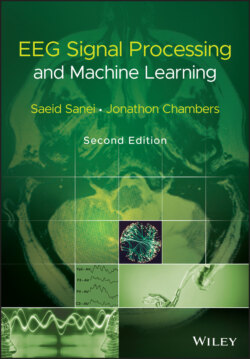Читать книгу EEG Signal Processing and Machine Learning - Saeid Sanei - Страница 32
2.8 Ageing
ОглавлениеThe ageing process affects the normal cerebral activity in awake and sleep human, and changes the response of the brain to stimuli. The changes stem from reducing the number of neurons and due to a general change in the brain pathology. This pathology indicates that the frontal and temporal lobes of the brain are more affected than the parietal lobes, resulting in shrinkage of large neurons and increasing the number of small neurons and glia [43]. A diminished cortical volume indicates that there is age related neuronal loss. A general cause for ageing of the brain may be the decrease in cerebral blood flow [43].
A reduction of the alpha frequency is probably the most frequent abnormality in EEG. This often introduces a greater anterior spread to frontal regions in the elderly and reduces the alpha wave blocking response and reactivity. The diminished mental function is somehow related to the degree of bilateral slowing in the theta and delta waves [43].
Although the changes in high‐frequency brain rhythms have not been well established, some researchers have reported an increase in beta wave activity. This change in beta wave activity may be considered as an early indication of intellectual loss [43].
As for the sleep EEG pattern, older adults enter into drowsiness with a more gradual decrease in EEG amplitude. Over the age of 60, the frontocentral waves become slower, the frequency of the temporal rhythms also decreases, and frequency lowering with slow eye movements become more prominent, and spindles appear in the wave pattern after the dropout of the alpha rhythm. The amplitudes of both phasic and tonic NREM sleep EEG [43] reduce with age. There is also significant change in REM sleep organization with age; the REM duration decreases during the night and there is significant increase in the sleep disruption [43].
Dementia is the most frequent mental disorder that occurs predominantly in the elderly. Therefore, the prevalence of dementia increases dramatically with ageing of the society. Generally, EEGs are a valuable diagnostic tool in differentiation between organic brain syndromes (OBSs) and functional psychiatric disorders [43], and together with EPs play an important role in the assessment of normal and pathological ageing. Ageing is expected to change most neurophysiological parameters. However, the variability of these parameters must exceed the normal degree of spontaneous variability to become a diagnostic factor in acute and chronic disease conditions. Automatic analysis of the EEG during sleep and wakefulness may provide a better contrast in the data and enable a robust diagnostic tool. We next describe particular and very common mental disorders whose early onset may be diagnosed with EEG measurements.
